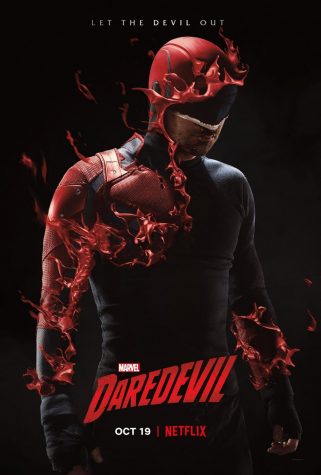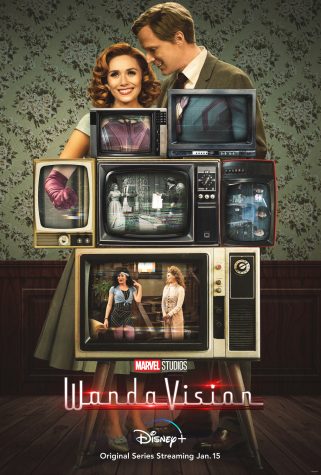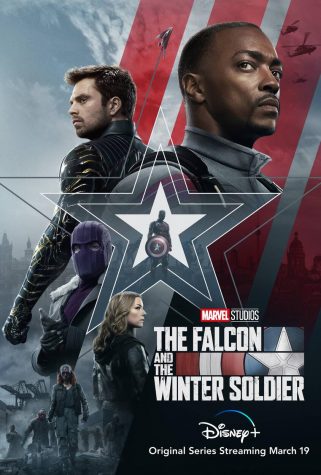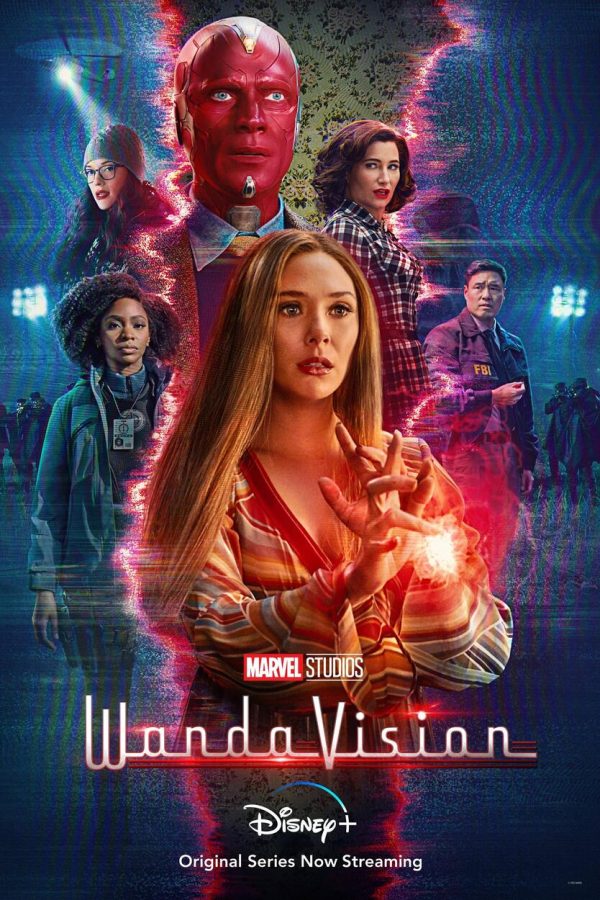WandaVision: Marvel’s Second Try on Television
January 15th saw the premiere of WandaVision, a brand new Marvel series and the first Marvel release in over a year after Black Widow and The Falcon and the Winter Soldier’s delay (that is, if you ignore Marvel’s Agents of S.H.I.E.L.D. that aired just last August). The premise is clear yet unrevealing: two Avengers, one of them curiously revived(?) after the events of Avengers: Infinity War, are stuck blissfully in sitcomland. Yet, despite the seemingly simple plot, Marvel takes this show to uncharted territory, and this second attempt at television demonstrates why Marvel’s storytelling resonates with audiences and is so successful.
 Spoiler alert: this article will contain more Marvel TV history than WandaVision. To get to where we are now, we have to describe Marvel’s first attempt, which included primetime TV series, Netflix shows, a Hulu show, and an oddball Freeform show. All of them were managed and produced by Marvel Television, a separate production company from Marvel Studios (which produces all of the films) in affiliation with ABC. ABC hosted the first-ever Marvel live-action series that also tied in with the movies, the aforementioned Agents of S.H.I.E.L.D. While the hype for the show was high, the show’s first season suffered a weak creative direction, leaning too heavily on the formats of other sci-fi series of the time, and it was not only until the second half of the first season where the plot really became a thing of its own. By then, however, the initial fanfare died down rather quickly, and while Agents of S.H.I.E.L.D. had a loyal following in its seven-season run (longest Marvel live-action series ever… so far), it never found its footing in the public conscience. People today still argue about whether the show can be considered canon in the Marvel Cinematic Universe. Marvel TV gave two more attempts on primetime TV with Agent Carter and Inhumans. The former, while much better in quality, suffered low audience from the beginning and was nixed after two seasons. The latter… let’s just not talk about that one.
Spoiler alert: this article will contain more Marvel TV history than WandaVision. To get to where we are now, we have to describe Marvel’s first attempt, which included primetime TV series, Netflix shows, a Hulu show, and an oddball Freeform show. All of them were managed and produced by Marvel Television, a separate production company from Marvel Studios (which produces all of the films) in affiliation with ABC. ABC hosted the first-ever Marvel live-action series that also tied in with the movies, the aforementioned Agents of S.H.I.E.L.D. While the hype for the show was high, the show’s first season suffered a weak creative direction, leaning too heavily on the formats of other sci-fi series of the time, and it was not only until the second half of the first season where the plot really became a thing of its own. By then, however, the initial fanfare died down rather quickly, and while Agents of S.H.I.E.L.D. had a loyal following in its seven-season run (longest Marvel live-action series ever… so far), it never found its footing in the public conscience. People today still argue about whether the show can be considered canon in the Marvel Cinematic Universe. Marvel TV gave two more attempts on primetime TV with Agent Carter and Inhumans. The former, while much better in quality, suffered low audience from the beginning and was nixed after two seasons. The latter… let’s just not talk about that one.
Marvel TV’s more successful efforts, however, were its Netflix series, a precedent for future shows to be hosted on streaming sites, and eventually Disney Plus. The headliner and the catalyst was Daredevil, arguably a cinematic masterpiece and one of the best offerings Marvel gave us ever. With high ratings and viewership, this show was a mammoth for both Marvel TV and Netflix, and this symbiotic relationship continued with spinoff characters; Jessica Jones, Luke Cage, Iron Fist, and The Punisher–collectively known as The Defenders-verse–all came to existence as a result of Daredevil’s massive success. While the ratings for each respective show and the crossover miniseries The Defenders (which included all the titular heroes mentioned minus The Punisher) varied, the series helped boost Netflix’s subscriptions and brought a more mature audience to Marvel’s offering. Part of the reason why the Netflix series are so successful is because of the artistic freedom the shows had relative to the more family-friendly Avengers movies, hence why the shows had a Mature Audience rating. The possibility of covering more mature, sensitive, and real-world topics makes the storytelling just much more compelling. In addition, we dive deeper into the flaws and mistakes of the titular characters, making these heroes more human, more relatable, and more approachable than their movie counterparts.
 The drawback of these Netflix shows, however, was continuity and its relationship with the movies; while all of them acknowledge the Avengers in some shape or form, rarely do the events of the movies ever affect the shows, minus the events of 2011’s The Avengers/Avengers Assemble. The shows are so far removed from the Marvel Cinematic Universe that it’s easy to forget they were in the same universe at all in the first place. Then, in 2018, Netflix decided that hosting Marvel shows were no longer worth the cost (despite the clear evidence otherwise), and one by one, the Netflix Marvel series got canceled. The most shocking cancellation was Daredevil, which continued to give Netflix high viewership even after its cancellation.
The drawback of these Netflix shows, however, was continuity and its relationship with the movies; while all of them acknowledge the Avengers in some shape or form, rarely do the events of the movies ever affect the shows, minus the events of 2011’s The Avengers/Avengers Assemble. The shows are so far removed from the Marvel Cinematic Universe that it’s easy to forget they were in the same universe at all in the first place. Then, in 2018, Netflix decided that hosting Marvel shows were no longer worth the cost (despite the clear evidence otherwise), and one by one, the Netflix Marvel series got canceled. The most shocking cancellation was Daredevil, which continued to give Netflix high viewership even after its cancellation.
The final two series Marvel TV produced that had any relation to the Marvel Cinematic Universe were Runaways (Hulu) and Cloak & Dagger (Freeform), dubbed the “Young Adult” series. Runaways was successful in its own right and Cloak & Dagger had its small following. However, both shows got canceled (see a pattern?). It seems that all Marvel TV shows, no matter how good or bad they are, are cursed to get canceled prematurely. Of all the shows, only Agents of S.H.I.E.L.D. had control as to when they ended the series.
Marvel TV was absorbed into Marvel Studios in 2019, meaning all future projects, minus the last season of Agents of S.H.I.E.L.D., are produced by Marvel Studios. By then, Marvel Studios had already begun tinkering around with TV series starring many of the characters from the movies, and, in April 2019, Marvel announced their slate of TV shows coming to Disney Plus in 2020– The Falcon and the Winter Soldier, WandaVision, Loki, and Marvel’s What If…?– with the shows set to be released in the order presented above. Anticipation built further when Marvel teased clips of the first three shows mentioned at the Super Bowl LIV in February 2020.
 There proved to be one slight complication, however: COVID-19. The coronavirus affected the entire world, much less the entertainment industry, and as a result, unfinished shoots were delayed for all Marvel shows and all Marvel movies were delayed. However, WandaVision had mostly finished their shots, and with a few extra shoots in August 2020, the show moved up on the roster to be released in January 2021.
There proved to be one slight complication, however: COVID-19. The coronavirus affected the entire world, much less the entertainment industry, and as a result, unfinished shoots were delayed for all Marvel shows and all Marvel movies were delayed. However, WandaVision had mostly finished their shots, and with a few extra shoots in August 2020, the show moved up on the roster to be released in January 2021.
How did the show turn out? With six episodes out by the time of writing, it’s safe to say that Marvel’s second flirtation with television series proved to be a hit. Critics and fans adored the homages to each decade of sitcoms while also praising the increasingly present horror elements of the show. Even with the heavy lifting done by the big-name movie characters, WandaVision’s style and narration are much closer to their Netflix counterparts, offering intriguing storytelling and an intricate plot. With WandaVision, Marvel was able to develop their lead characters, Wanda Maximoff and Vision, into complex beings way more than the movies ever could, especially with the emphasis on Wanda’s mental health and how she is handling trauma (not well, if you’ve been watching the series). It’s a perfect balance between comedy, action, and mystery and the show is not shy to bring in lead female characters such as Darcy Lewis (from Thor) and Monica Rambeau (from Captain Marvel) to elevate the show’s dynamics.

Marvel is planning more shows in the future, and if any of them are like the quality of WandaVision, then we will be having a good slate of not only good superhero shows but good television shows. There was also news that Marvel might bring back the characters from the canceled Netflix shows, a prospect that would only advance Marvel’s ambitions to stake a claim in television. One can only hope that this second attempt will last longer than their poorly timed and unlucky first attempt.

Derek Wong is a senior who likes discussing hot topics relating to politics and the entertainment industry. He frequently participates in Model UN, loves...


Ali Wu • Feb 12, 2021 at 5:04 pm
pretty wack